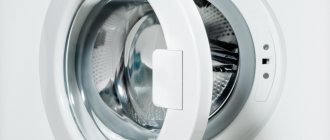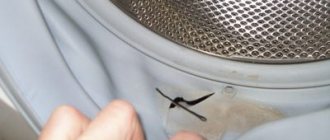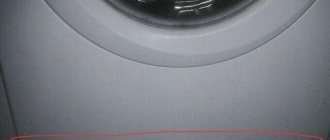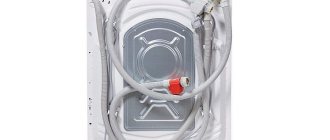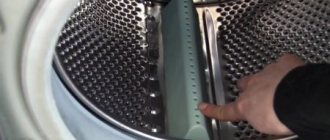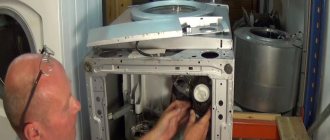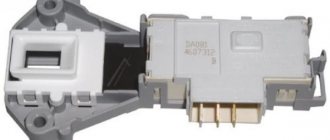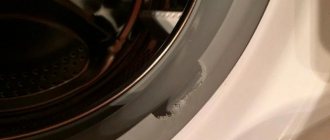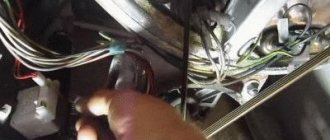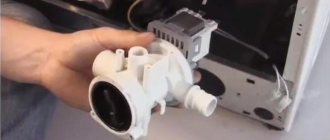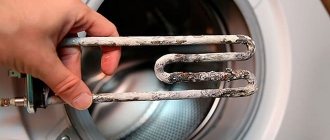Operating principle and types of locks
Today, two types of locks are commonly found:
- Electromagnetic.
- Bimetallic.
The first type is used less and less. Its main drawback is that the lock only works properly as long as there is electricity. If the light is turned off, the washing machine will not be unlocked.
The operating principle of a bimetallic lock is very simple: voltage is applied to the thermal element and heats it up. The hot thermocouple heats up the bimetallic plates; under the influence of heat, they expand and press on the lever. It goes off and blocks the door. At the end of the program, the voltage supply to the lock stops, the plates cool down, narrow and the latch returns to its original place. The washing machine hatch is unlocked.
The second type of locks has a number of advantages. Firstly, there is a delay in unlocking the hatch at the end of the program. This is necessary so that the washing machine completely drains the water and all its elements complete their work. Secondly, even if the power goes out, the lock will unlock, and the door can be opened and the laundry taken out. This type of UBL is used by many modern manufacturers of washing machines - LG, Samsung, Indesit, etc.
What is UBL (Hatch Lock Device) in a washing machine
The electrical door lock of the washing machine is activated when the door is closed. Fixation is carried out using a simple spring mechanism, while the latch can move inside the hatch lock. The door remains closed while the machine motor and drum rotate.
The device comes in 2 types:
- thermal locks with bimetallic plates;
- electric locks with electromagnets.
Manufacturers of Ardo washing machines mainly use the first option. Thermal locks are highly reliable. It has an advantage over an electric lock: if the power goes out, it will unlock automatically in a few minutes. When an electromagnetic device is installed in the appliance, the electrical power supply must be restored to clear the lock .
The role of UBL, how it works
The hatch is locked automatically after pressing the “Start” button . Voltage is applied and the UBL is activated. When the wash is finished, the lock is removed after 1-4 minutes, after which the door opens manually. If the door is open when starting the program, an error appears on the display of the Indesit washing machine.
Reasons for lock failure
There are several reasons why the door lock of a washing machine breaks.
- Firstly, this is the wear of bimetal plates as a result of prolonged use of the equipment. As a result of regular deformation, their functional properties are lost.
- Secondly, the reason may be a short circuit.
In some cases, the problem may not be with the UBL. If the washing machine has finished working, but the door does not open, the triacistor on the central board responsible for the operation of the lock may be faulty. In this case, voltage continues to flow to the locking device and as a result the door remains locked.
The lock handle on the hatch door is broken
The washing machine has turned off, the user decides to take out the laundry, but the handle suddenly breaks and the door does not open. Trying to open the door by force can lead to even worse consequences. It is better to use the “emergency door opening” (if such a function is available), a lock or tools.
What to do?
You should buy a new handle and install it after removing the old one, this can be done as follows:
- Remove the door from the front mountings using a screwdriver.
- Next, unscrew all the bolts around the perimeter and disconnect the halves of the structure
- Pry up the glass and remove it
- After this, you should remove the metal rod on which the handle is held. To do this, you need to push a nail or other thin object into the bolt and carefully pry it off.
- After removing the handle and its components, install a new one, performing all the described steps in reverse order.
Video instruction: replacing the hatch handle on an Electrolux EWC1050
This is interesting: The machine knocks out when you turn on the washing machine: causes of malfunction, expert advice
Symptoms of a problem
The owner of a washing machine can determine if the lock is broken by the following signs:
- The equipment completed its work and turned off, but the hatch was still blocked. This indicates a malfunction of the UBL or central module.
- After selecting and turning on the mode, the door does not lock and the washing machine does not start executing the program.
- The washing machine displays a code or reports a UBL malfunction by flashing indicators in a certain sequence.
You can determine what the cause of the breakdown is using a multimeter.
What if the device is broken?
A non-functioning UBL, among other breakdowns, may prevent the washing machine from starting a new cycle. To accurately determine whether a lock needs repairs, you only need to take a couple of steps.
First, open the door, expose the lock and find the movable plate. We move it to the “working” position and connect the multimeter probes to the contacts. We evaluate its performance by checking the displayed values with the established norm. Then we don’t relax and pay attention to how the locking mechanism behaves after the tension is relieved. If the click does not occur automatically, there is a problem.
Faulty constipation leads to unpleasant situations. For example, after the wash is completed, the hatch door does not open and the washed items cannot be removed from the drum. To solve the problem you will have to:
- Disconnect the washing machine from the power supply and water supply.
- Unscrew the screws from the back of the case and remove the top panel.
- Tilt the machine back.
- Move the metal bolt from the hatch hook by hand.
There is also an absolutely opposite situation, when even with strong pressure the UBL does not work and the door does not close. Accordingly, the washing does not start - the control board does not receive a signal about the drum being tight. In such cases, most likely the lock has become worn and weakened. To find out, you need to unscrew the hatch door and check the condition of the blocker with a multimeter and visual inspection.
If a defect is detected, the UBL should be replaced. To do this, the lock will have to be dismantled and a similar copy installed in its place. The algorithm is as follows:
Important! It is recommended to record the disassembly on the camera to facilitate the assembly process and avoid errors and confusion.
- We open the hatch.
- Remove the outer clamp from the cuff.
- We fill the rubber seal inside the drum.
- Carefully unscrew the bolts holding the lock.
- We get UBL.
- We install the new device in the reverse order.
Having figured out how the washing machine hatch door lock works, you can not panic when the door is locked, but quickly and correctly assess the scale of the problem on your own. The main thing is not to let the operation of the machine take its course, do not forget about prevention and careful care. Then the machine will last a long time and save its owners from accidents, floods, mold and unpleasant odors.
Interesting:
- Washing machine door closing sensor
- How to check the lock of a washing machine
- How to check the lock of an Indesit washing machine?
- How to change UBL on a Bosch washing machine?
- The lock on the Indesit washing machine does not work
- LG washing machine hatch won't close
Reader comments
- Share your opinion - leave a comment
Diagnostics and repair of the lock on your own
To check the serviceability of the lock, it will need to be removed. Necessary:
- Unplug the washing machine.
- Open the hatch, bend the cuff, pry up the clamp and remove it.
- Pull the cuff to the side to gain access to the lock.
- Unscrew the fasteners securing the device.
- Disconnect the wiring and pull out the UBL.
This method is suitable if the door opens. Otherwise, you need to open the base panel on the front of the washing machine and find the emergency cable for opening the hatch. It is usually yellow or red and is located near the filter. If the cable is missing, you need to unscrew the fasteners holding the top cover, remove it, and then put your hand between the body and the tank, find the lock latch by touch and unlock it. Now you can open the door and begin removing the UBL.
Now you can start checking the blocker using a multimeter. To determine where the neutral and common contacts are located, you will need a diagram of the lock. Hatch locking devices are produced by various companies that arrange the contacts in their own way. Without knowing the diagram, it is impossible to understand the contacts and diagnose the lock. You can find the diagram on the Internet.
At home, you can only check the thermoelement that heats the plates. To do this you need:
- Set up the multimeter to measure resistance.
- Find the neutral and phase contacts and install probes on them.
- If a three-digit number appears on the tester display, this indicates that the blocker is working.
- Now you need to move the probes to the neutral and common contacts.
- If one or zero appears on the screen, the device is broken.
If the blocker is working properly, you need to inspect it for mechanical damage or manufacturing defects.
To replace, you need to purchase a new lock. This can be done at the manufacturer's service center, in a specialized store, or via the Internet. To avoid mistakes when purchasing a part, you need to tell the seller the make and model of the washing machine.
Installing the hatch lock is performed in the following order:
- Connect the wiring to the UBL.
- Place the lock inside the washing machine and insert it into the seat.
- Screw in the fastener.
- Return the cuff to its original place and install the clamp.
If after replacing the UBL the problems continue, this indicates a malfunction of the system board. It is not recommended to repair it yourself, because it can only worsen the situation. To diagnose and repair the breakdown, you should contact a service center or call a professional.
Some washing machine owners are interested in whether it is possible to bypass the lock and start washing. Theoretically, there is such a possibility, but in this case, everyone who has access to the technology will be at risk of electric shock. Also, if you open the unlocked door during washing, there is a risk of being scalded by hot water. It is for these reasons that it is recommended to carry out repairs and replace a part that is inexpensive, rather than searching for a way to bypass the blocking.
Hatch locking device
When starting to check, it is important to understand what type of lock is installed in your model of automatic washing machine (WMA). In older SM releases, manufacturers installed blockers with an electromagnet
However, they were ineffective without electricity. If the electricity was turned off during washing, the hatch automatically unlocked.
Another thing is the hatch door lock based on bimetallic plates. They are used everywhere due to their efficient operation.
The structure consists of three main elements:
- thermoelement;
- bimetallic plate;
- fixing device.
How does UBL work? Everything is tied to electronics. The electronic board supplies current to the thermocouple, which heats up quickly. This, in turn, is applied to the plate, which, increasing in size, pushes out the latch. Typically, when you start a cycle, you will hear a click, which means the door is locked and ready to draw water.
The principle of operation of the lock has been disassembled. Now let's talk about its problems: for what reasons does a breakdown occur?
Reasons for the malfunction of the lock in the washing machine
There are two main causes of breakdowns: physical wear and tear and electronic problems.
- Constant deformation of the plates when heated leads to damage and destruction of the element. In such cases, fixation does not work at all.
- Power surges in the network can lead to breakdown of the thermoelement. Then it does not heat up, therefore, the plate remains in place. The short circuit of the control triac results in the door not opening. Current is continuously supplied to the parts, so the latch does not turn off.
What should I do if there is a problem? Check the lock of the washing machine and replace it if it is faulty.
How to check the UBL of a washing machine with a tester?
The first thing that catches your eye when a breakdown occurs is the abnormal operation of the equipment. Here are the signs that indicate problems with UBL:
- The hatch does not open even several hours after the wash is finished.
- A code was displayed on the display of the washing machine, which indicates a problem with the blocker.
- The door will not unlock even after disconnecting the appliance from the power supply.
- During startup, the lock does not work and the hatch does not close.
Most often, either the element itself or its wiring and control module fail. A multimeter will help you accurately determine the cause of the breakdown.
To perform diagnostics, you will need the electrical diagram of the device. It may be different for each model, because manufacturers arrange the contacts differently.
What you need to find out:
- Where is the “neutral” contact located?
- Where is "general" located?
- Where is the “phase” located?
Prepare a multimeter and adjust it to measure resistance. You can get to the lock the same way in all front models:
- Open the door.
- Unscrew the two mounting bolts.
- Bend down the sealing collar.
- Place your hand behind your body.
- Get the UBL.
- Disconnect the wiring.
Now place one tester probe on the neutral contact and the other on the phase contact. Three-digit values are considered normal.
Next, place one probe against the neutral contact, and the other against the common one. The device is considered broken if the values are 1 or 0.
The tester did not find a fault, but the lock does not work? Inspect the lock itself; perhaps the reason is the wear of the bimetallic element. The lock cannot be repaired; it must be replaced immediately. Buy an identical part from the store, connect the wires and install it in its original place. Watch the video for details:
How to perform diagnostics if the sunroof is blocked? There is an easy way to open it:
- Take a thin ribbon.
- Pass it between the door and the SMA body.
- Pull firmly on both ends.
- The latch should give way.
Lastly, the control board is inspected. Its triacs often suffer from oxidation and burns. The reason for this is unstable voltage in the network and high humidity in the room. It is better to entrust module repair to a specialist.
To maintain the functionality of the washing machine electronics, connect the equipment through a voltage stabilizer. Before starting repairs, unplug the plug from the outlet.
Bad 7
Interesting 18
Super
